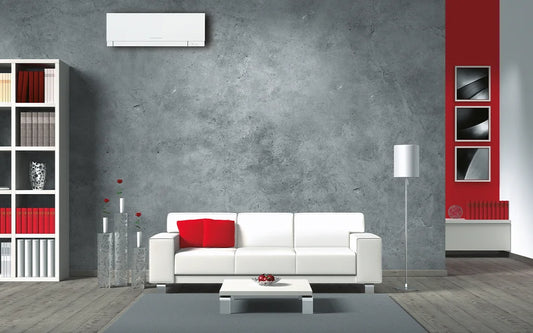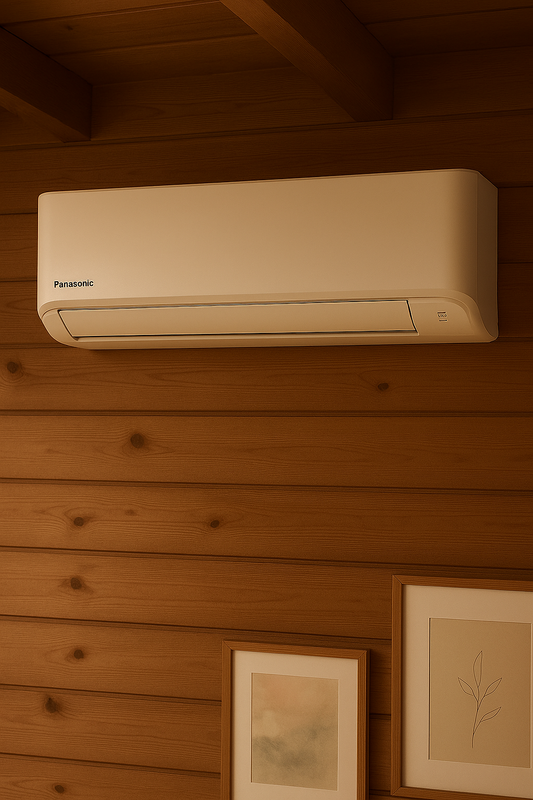Installation av luft-luft värmepump: Allt du behöver veta
Inledning
Att installera en luft-luft värmepump kan vara ett effektivt sätt att förbättra inomhusklimatet samtidigt som man minskar energikostnaderna. I denna artikel kommer vi att utforska processen för installation av luft-luft värmepump, dess fördelar, användningsområden och vanliga frågor.
Definition och bakgrund
En luft-luft värmepump är en typ av uppvärmningssystem som tar energi från utomhusluften och överför den till inomhusutrymmen för att skapa värme. Denna process möjliggörs genom en värmepumpsprincip som utnyttjar värmeenergin som finns i luften, även vid låga utomhustemperaturer. Denna teknik är särskilt vanlig i områden med måttliga vintrar och kan även användas för att kyla inomhusutrymmen under sommarmånaderna.
Fördelar och användningsområden
En av de främsta fördelarna med luft-luft värmepumpar är deras energieffektivitet. Genom att utnyttja befintlig värmeenergi i utomhusluften kan de minska energiförbrukningen och därmed sänka elkostnaderna. Dessutom kan dessa värmepumpar bidra till en jämnare inomhustemperatur och förbättra luftkvaliteten genom att filtrera och cirkulera luften.
Luft-luft värmepumpar är lämpliga för både bostäder och kommersiella fastigheter. De kan installeras i enstaka rum eller som helhetslösningar för hela byggnader. Denna flexibilitet gör dem till ett populärt val för olika användningsområden, från villor och lägenheter till kontorslokaler och butiker.
Relaterade tekniker, begrepp eller variationer
Det finns flera varianter av värmepumpar, varav luft-luft värmepumpar är en. Andra vanliga typer inkluderar luft-vatten värmepumpar och bergvärmepumpar. Dessa system skiljer sig åt i hur de utvinner och överför värmeenergi, vilket kan påverka deras lämplighet för olika geografiska områden och fastigheter.
Vanliga frågor (FAQ)
-
Hur lång tid tar det att installera en luft-luft värmepump?
Installationsprocessen kan variera beroende på fastighetens storlek och befintliga system. Generellt sett kan en standardinstallation ta mellan 1-3 dagar. -
Vilken typ av underhåll kräver en luft-luft värmepump?
För att bibehålla optimal prestanda bör luftfilter rengöras eller bytas regelbundet och systemet bör genomgå årlig service av en kvalificerad tekniker. -
Kan en luft-luft värmepump användas för att kyla inomhusutrymmen?
Ja, många luft-luft värmepumpar har även en kylfunktion för att reglera inomhustemperaturen under varmare månader.
Sammanfattning
Installation av en luft-luft värmepump kan erbjuda många fördelar, inklusive energieffektivitet, förbättrad inomhuskomfort och flexibilitet i användningen. Genom att förstå dess funktion, användningsområden och underhållskrav kan fastighetsägare fatta informerade beslut när det gäller att investera i denna teknik.
Installation Process
The installation process for a air-to-air heat pump involves several key steps. First, a qualified technician will assess the property to determine the optimal location for the outdoor unit and the indoor air handlers. Next, the necessary electrical and refrigerant lines will be installed to connect the outdoor and indoor units. Finally, the system will be tested to ensure proper functionality and efficiency.
Energy Efficiency Benefits
One of the notable benefits of air-to-air heat pumps is their energy efficiency. By harnessing heat energy from the outdoor air, these systems can provide heating at a fraction of the cost compared to traditional electric heating methods. This can lead to significant savings on utility bills, particularly in regions with moderate climates.
Enhanced Indoor Air Quality
In addition to heating and cooling, air-to-air heat pumps can also improve indoor air quality. Many models are equipped with air filters that can capture dust, pollen, and other airborne particles, helping to create a healthier living or working environment.
Cost Considerations
While the initial investment for an air-to-air heat pump installation can vary based on factors such as system size and complexity, it's important to consider the long-term cost savings. Additionally, some regions offer incentives or rebates for installing energy-efficient heating and cooling systems, which can offset the upfront expenses.
Case Study: Residential Installation
In a residential setting, the installation of an air-to-air heat pump can transform the comfort and energy efficiency of a home. By strategically placing indoor air handlers in key living areas, occupants can enjoy consistent heating and cooling throughout the year, while reducing their reliance on traditional HVAC systems.
Environmental Impact
By utilizing heat energy from the air, air-to-air heat pumps can contribute to lower carbon emissions compared to conventional heating methods. This can align with sustainability goals and environmental initiatives for both residential and commercial properties.
Installation Process Continued
Once the system is installed, it's important to ensure that the outdoor unit is placed in a well-ventilated area and free from obstructions that could affect its performance. Proper spacing and clearance around the unit are critical for optimal operation.
Warranty and Maintenance
Most air-to-air heat pump manufacturers offer warranties for their products. It's essential for homeowners and property managers to familiarize themselves with the warranty terms and recommended maintenance procedures to uphold the system's performance and longevity.
Remote Control and Smart Integration
Many modern air-to-air heat pump models are equipped with remote control capabilities and smart integration features. This allows users to adjust temperature settings and monitor energy usage from their smartphones or other connected devices, providing convenience and energy management benefits.
Professional Installation Considerations
While some homeowners may consider DIY installation, it's generally recommended to enlist the services of a licensed HVAC professional for air-to-air heat pump installation. This ensures compliance with local regulations, proper sizing, and optimal performance.
Geographic Considerations
When considering the installation of an air-to-air heat pump, it's important to take into account the specific climate and environmental conditions of the property's location. Factors such as temperature extremes and air quality can influence the system's efficiency and suitability.
Advanced Features and Add-Ons
Some air-to-air heat pump systems offer advanced features such as zoning capabilities, which allow for independent temperature control in different areas of a building. Additionally, add-ons such as energy recovery ventilation can further enhance indoor air quality and energy efficiency.
Energy Savings and Return on Investment
Over time, the energy savings generated by an air-to-air heat pump can contribute to a favorable return on investment. By reducing reliance on traditional heating and cooling methods, property owners can recoup the initial installation costs and continue to benefit from long-term savings.
Noise Levels and Sound Considerations
When selecting an air-to-air heat pump, it's important to consider the operating noise levels, especially for residential applications. Many modern units are designed to operate quietly, ensuring minimal disruption to occupants while providing efficient heating and cooling.
Smart Thermostat Integration
Integrating a smart thermostat with an air-to-air heat pump can further enhance energy management and user control. This allows for personalized scheduling, remote adjustments, and energy usage monitoring, optimizing comfort and efficiency.
Insulation and Building Envelope Considerations
The effectiveness of an air-to-air heat pump can be influenced by the insulation and overall building envelope. Proper insulation and sealing of air leaks can maximize the system's performance and minimize energy loss, complementing the heating and cooling benefits.
Commercial Applications and Scalability
For commercial properties, air-to-air heat pumps offer scalability and flexibility to meet diverse heating and cooling demands. From small office spaces to large retail establishments, these systems can be tailored to provide efficient climate control while aligning with commercial sustainability objectives.
Safety and Compliance Standards
Ensuring the safety and compliance of an air-to-air heat pump installation is essential. Adhering to local building codes, electrical regulations, and manufacturer specifications is imperative to guarantee the system's safe operation and longevity.
Seasonal Performance and Defrost Cycles
In regions with cold winters, air-to-air heat pumps utilize defrost cycles to maintain optimal performance. Understanding the system's seasonal efficiency and defrost operation can help property owners optimize its use in varying weather conditions.
Remote Diagnostic and Monitoring Capabilities
Advanced air-to-air heat pump models may offer remote diagnostic and monitoring capabilities, allowing HVAC professionals to remotely assess system performance, troubleshoot issues, and proactively address maintenance needs, enhancing overall reliability.
Life Cycle Assessment and Environmental Impact
Conducting a life cycle assessment of an air-to-air heat pump can provide insights into its environmental impact across its operational lifespan. This holistic approach evaluates factors such as energy consumption, emissions, and end-of-life considerations for sustainable decision-making.
Training and User Education
Providing comprehensive training and education to end-users is crucial for maximizing the benefits of an air-to-air heat pump. Understanding system operation, maintenance best practices, and energy-efficient usage can empower occupants to optimize their indoor comfort and energy savings.
Adaptive Defrost and Smart Control Algorithms
Some air-to-air heat pumps feature adaptive defrost and smart control algorithms, which continuously optimize the system's performance based on ambient conditions and usage patterns. This dynamic approach enhances efficiency and comfort while minimizing energy consumption.



